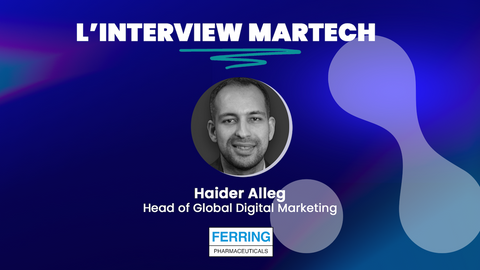As part of the launch of our Martech Insider Newsletter, we will regularly feature interviews with marketing and digital professionals, who will present the technologies they use and their objectives.
For February 2019, Haider Alleg, Head of Global Digital Marketing at Ferring Pharmaceuticals, talks to us about his "Technology Stack" and the Group's "Suite Solutions" Strategy!
Hello Haider,
Can you introduce yourself?
I am Haider Alleg, Head of Global Digital Marketing at Ferring Pharmaceuticals in St-Prex, Switzerland. I've been working in Pharma since 2008 and in digital marketing since 2004. I have experience in agencies, consulting firms, startups, and corporate environments. I've also had the opportunity to work in different regions around the world, giving me a broad perspective on the needs of my brands. Most of these brands, about 80%, are prescription-based and provided by healthcare professionals. Ultimately, I feel like I'm running a new type of commercial and marketing department, primarily relying on digital tools.
My department is responsible for the digital experience of patients and healthcare professionals. I also optimize the sales force through multichannel strategies. My mission is to boost brand reach, optimize audience and brand experiences with personalized content and services, and of course, enhance the agility of our marketing and sales activities for greater efficiency.
How does regulation impact your choice of marketing tools?
Externally, it's about adhering to market-specific codes of conduct. Often, tools are designed for a general market, but regulations might require us to blur a logo in France but not in the USA. Internally, the challenge lies in the processes and workflows that need to be established between various departments. The chosen tool must facilitate this collaborative work across different departments and countries. All tools are reviewed by legal, compliance, and regulatory teams. While I sometimes wish to use mainstream tools, these constraints often push us towards vertical tools that are often technologically behind the competition (especially in terms of features). Examples of such market players include Viseven or specialized software suites like IQVIA. We comfort ourselves by thinking that it's better to have strong adoption of a specialized tool than 10% usage of a more advanced SaaS tool that's less adapted to our internal vocabulary.
Can you tell us how many solutions constitute your technology stack currently?
I would say less than 10. They follow a lifecycle logic based on the digital maturity of our brands. We manage our digital marketing projects for our brands in 8 stages:

We try to have a maximum of one player per step with a backup. This is also driven by our procurement strategy, which guides us to have fewer solutions but deeper adoption. Something as simple as whether a tool allows account management with invoicing (blocked by a credit card) also influences our choice.
- Trello + Smartsheet
- Radarly + Linkfluence
- Consulting Partners + Gartner
- WordPress — Amazon — Crowdin — Gitlab — Cloudflare
- Programmatic buying (RFP going)
- IQVIA
- Hootsuite
- Mautic
- PowerBI
How do you think this technology stack will evolve? Are you pursuing a "best of breed" or "Suite Solutions" strategy?
Ideally, we prefer turning to suite solutions for our technology stack. We already see this with Microsoft, Google, and Amazon, where we source multiple solutions. The Suite Solutions model suits our group better because functionalities and usage are designed to be global. A niche player can stand out but must have the capacity to scale globally quickly, as is the case with Trello, Hootsuite, and Linkfluence, which are also part of our technology stack.
What is your tool selection process?
For our digital marketing strategies, we have implemented 8 key steps, each associated with a tool to help our teams save time and collaborate effectively. Our tool choices are based on these steps. When a need arises, we analyze the market to understand the main players and their value propositions. We also consider solutions offered by GAFAM suites. Our goal is to meet needs, not multiply partners. We always submit actors to an RFP. We make an initial shortlist before meeting with relevant vendors. Our legal teams are involved early in the decision-making process, and we maintain a focus on rapid deployment capabilities.
For the mentioned tools, do you use add-on services or operate as power users?
We operate as power users. Our internal policy is not to have a large number of solutions but to optimize the use of each one. Depending on the challenges the solution addresses, we designate one or more internal power users to evangelize within the group or perform actions and disseminate them.
Can you mention one or more tools you would like to test or have at your disposal?
We would like to automate certain processes, such as community management, where we could automate the qualification of incoming posts for better information routing. It's very challenging to find real machine learning applications in SaaS tools that would save us valuable time. As mentioned, we are currently in an RFP process for a programmatic buying tool. We are also considering and sourcing remote detailing tools and voice bots, which should help provide new services to our healthcare professionals.
And a favorite tool?
My recent favorite is finity.ai. It's a data visualization or filtering layer that brings a very pragmatic business context to my various functions. Finity, for example, tracked the WEF in Davos for KPMG.
Thank you, Haider, for your time and detailed responses!
Do you have any thoughts on these tools? Want to know more?
Looking for more interviews with marketing and digital professionals?
Check out the interview with Thierry Moussu, Head of Digital Relations at Total Direct Energie.





